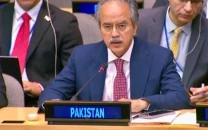$3b donor-funded projects under way in flood-hit areas
Planning ministry says project being implemented in 4RF framework

Since the launch of Resilience, Recovery, Rehabilitation and Reconstruction (4RF) framework by the planning ministry, the Central Development Working Party (CDWP) approved 21 development projects worth $3billion for flood-affected areas of Pakistan while securing maximum pledges committed in Geneva for flood 2022, according to a press release issued here on Sunday.
Last year Pakistan faced an unprecedented devastation due to torrential rains and flooding in most parts of the country, particularly in Balochistan and Sindh, affecting 33 million people and resulting in economic losses worth $30 billion.
In response, the government had devised the 4RF framework, which proposed effective coordination and participation arrangements among federal and provincial governments, development partners, donors, international and national NGOs and academic and private sectors.
In January, Pakistan secured pledges of $10 billion from donors during an international conference on ‘Climate Resilient Pakistan’, jointly hosted by Pakistan and the UN in Geneva. Since then, the CWDP had approved 21 development projects in the affected areas.
The projects include Emergency Flood Assistance Project (EFAP) on Farm Water Management worth $475 million, Access to Clean Energy worth $47 million, DRR project for Rehabilitation and Reconstruction worth $31.28m; Emergency Flood Assistance Project worth $8 million; Post-Flood 2022 Reconstruction Programme: Resilience Enhancement and Livelihood worth $400 million; Sindh Irrigated Agriculture Productivity Enhancement Project worth $8.3 million; Competitive and Livable City of Karachi worth $27 million; Sindh Flood Housing Reconstruction worth $500 million; Flood Emergency Rehabilitation Project Sindh worth $500 million; Sindh Water and Agriculture Transformation Project worth $98 million; Khyber-Pakhtunkhwa (K-P) Rural Accessibility Project worth $300 million; K-P Irrigated Agriculture worth $11.7 million; K-P Integrated Tourism Development worth $2 million; K-P Human Capital Investment worth $25 million; Pakistan Hydromet and Climate Services Project worth $150 million; Crisis Resilience Institutions for Social Protection (CRISP) worth $73.14 million; Pandemic Response Effectiveness Programme worth $2 million; Punjab Tourism for Economic Growth worth $2.8 million; Sindh Integrated Health and Women Empowerment worth $50 million; Polio Eradication Programme worth $100 million and K-P Food Security Support Project worth $100 million.
Read also: Provinces asked to submit list of projects for flood-hit areas
“After the approval of the CDWP and Executive Committee of the National Economic Council [Ecnec], these projects are being successfully executed by the respective provinces funded by the World Bank, Asian Development Bank (ADB) and the Islamic Development Bank,” the press release said.
On the other hand, the Federal Steering Committee (FSC), established to implement the projects, has been actively working and three meetings of the FSC were held for implementation of development projects in the flood–affected areas.
The committee regularly asked the provinces about the implementation status of their respective projects. “The first-ever exclusive dashboard for 4RF, which will be made operational by November 10 will ensure real-time monitoring and provide information to the public as well development partners about the execution of development projects in the flood-affected areas,” the release added.
Pakistan has been witnessing challenging impacts of climate change, ranging from devastating floods to prolonged droughts, from heat waves to melting glaciers. These changes pose immense threats to the country’s environment, economy, and the well-being of the people.
Pakistan’s carbon emission is less than 1%; however, it is among the countries most vulnerable to climatic disasters. The World Bank has already appreciated Pakistan’s efforts to successfully approve the projects and assured its continued support in the future.


















COMMENTS
Comments are moderated and generally will be posted if they are on-topic and not abusive.
For more information, please see our Comments FAQ